written and photographed by Mary L. Peachin
Jan 2000, Vol. 4 No. 4
 I entered the tiny, airless, yet musty, cube with trepidation. During the Vietnam War, my friend Colonel Bob Barnett, an American fighter pilot, had spent five years in this small prison cell. I looked at the set of rusty shackles, still bolted to a cement bunk in an unlit cell, and wondered if they had held Bob’s legs. Was that the bucket he used as a latrine? A separate cell was empty save another bucket-the shower? A small table holding a single cup appeared to be the dining cell. As I walked through the “Hanoi Hilton,” the infamous Vietnam War POW prison, I marveled at how such a horrendous place had been converted into a museum. And I tried to weave the stories of Bob’s imprisonment into what lay before me.
I entered the tiny, airless, yet musty, cube with trepidation. During the Vietnam War, my friend Colonel Bob Barnett, an American fighter pilot, had spent five years in this small prison cell. I looked at the set of rusty shackles, still bolted to a cement bunk in an unlit cell, and wondered if they had held Bob’s legs. Was that the bucket he used as a latrine? A separate cell was empty save another bucket-the shower? A small table holding a single cup appeared to be the dining cell. As I walked through the “Hanoi Hilton,” the infamous Vietnam War POW prison, I marveled at how such a horrendous place had been converted into a museum. And I tried to weave the stories of Bob’s imprisonment into what lay before me.
I was the sole visitor that day; the “Hilton” is not on the tourist circuit for most Western visitors in Vietnam. It was not listed as an attraction in the guidebooks I read. Instead, I had made a specific request to visit the prison because of Bob’s stories-his suffering and his memories.
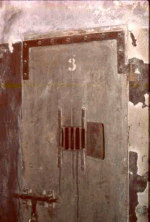 Twenty-five years after Bob’s ordeal, much of the camp has been replaced by development-including the bright façade of a new hotel. It is easy to drive down the busy road, to miss what’s left of the prison wall, a stone cliff still covered with barbed wire and electrified cable.
Twenty-five years after Bob’s ordeal, much of the camp has been replaced by development-including the bright façade of a new hotel. It is easy to drive down the busy road, to miss what’s left of the prison wall, a stone cliff still covered with barbed wire and electrified cable.
Americans are used to being the winners in every situation. Visiting Vietnam, now unified under a Communist government-a country that defeated the United States in war-tipped the scales and forced me to look at things from another perspective. The sights were fascinating, but my mind churned, focused on the past.
In the quarter century since the U.S. pulled out, Vietnam has changed quite a bit. Little visible reminder of the war exists, and the country has modernized significantly, welcoming tourists to experience its mix of old Asia, crumbling French colonialism, and millennial rejuvenation.
One of the top tourist attractions in Hanoi is the Ho Chi Minh Mausoleum. Each day tens of thousands of people visit the dead leader’s glass sarcophagus, which lies inside a large marble edifice. The building is surrounded by groves of bamboo and the entrance is decorated with symbolic funerary wreaths.
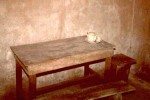 All foreign visitors are allowed to “crash” the line of thousands of school children and other Vietnamese, reducing the wait to about 30 minutes. Communist Army officers brusquely divided the tourists into groups of three, checking to see that we were properly dressed (long sleeves and pants; no hats), and carried no cameras or handbags. As the line approached the interior of the mausoleum, a soldier pushed me into what had now become a double line.
All foreign visitors are allowed to “crash” the line of thousands of school children and other Vietnamese, reducing the wait to about 30 minutes. Communist Army officers brusquely divided the tourists into groups of three, checking to see that we were properly dressed (long sleeves and pants; no hats), and carried no cameras or handbags. As the line approached the interior of the mausoleum, a soldier pushed me into what had now become a double line.
Despite the masses of people, there was total silence inside the sarcophagus: everyone moved stiffly. Tour guides are trained to warn visitors of the unexplained policy of not putting hands into pockets. We marched slowly around the sarcophagus, our eyes glued to the hero of the Vietnamese people, and marched out again.
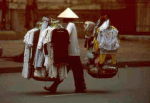 Hanoi was built in 1010 along the Red River delta, in the center of what was formerly North Vietnam. Numerous lakes frame the city, which boasts the classic architecture of the Old Quarter and more than 600 pagodas. Despite such “progress,” the city has a limited tourist infrastructure. There were no modern conveniences, and finding even a non-Western restroom, a non-flushing hole with two tile footstep impressions, was a real challenge. But Hanoi provided two fascinating days of my life.
Hanoi was built in 1010 along the Red River delta, in the center of what was formerly North Vietnam. Numerous lakes frame the city, which boasts the classic architecture of the Old Quarter and more than 600 pagodas. Despite such “progress,” the city has a limited tourist infrastructure. There were no modern conveniences, and finding even a non-Western restroom, a non-flushing hole with two tile footstep impressions, was a real challenge. But Hanoi provided two fascinating days of my life.
Prior to arriving in Vietnam, I had made arrangements to tour with an English-speaking guide. Pham Hong Chuong took me to several “obligatory” tourist sights: the Ho Chi Minh Mausoleum, the 18th century Ngoc Son Temple on an island in Hoan Keim Lake, and the Temple of Literature, which dated back to 1070.
At this point I had had enough of the postcard circuit. I asked Chuong to show me daily life in Hanoi. I wanted to become immersed in the culture, to learn how the Vietnamese worked, played, and lived.
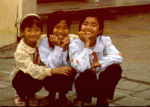 Chuong asked the driver of our air-conditioned Toyota Camry to pull over and we set off through the Old Quarter of Hanoi. Each of the narrow streets has one small shop after another, each selling only one item-silk, enamel, embroidery, housewares, shoes.
Chuong asked the driver of our air-conditioned Toyota Camry to pull over and we set off through the Old Quarter of Hanoi. Each of the narrow streets has one small shop after another, each selling only one item-silk, enamel, embroidery, housewares, shoes.
Other markets, including the large Dong Xuan and smaller Hang Da, specialized in one type of food, vegetable, or spice. Hang Da’s fish section featured tanks and tubs of live seafood, including rarities such as stingray, snail, and several varieties of eel. There were many varieties of rice, noodles and delicacies such as black eggs.
Fruit and flowers were displayed like works of art. Curious about the beautiful “red dragon” fruit (thanh long), I was disappointed to taste flavorless white pulp loaded with small black seeds. The fruit I recognized, including mangos, papayas, watermelon, and pineapple proved juicy and fresh.
We walked for miles. At every juncture, I was forced into sensory overload, accompanied by fight-or-flight panic: there are very few traffic signals in Hanoi. Chuong instructed me to stay close as we crossed the traffic-laden streets.
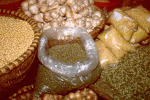 Hanoi traffic operates under a complex, unwritten pecking order that gives the right-of-way first to oxen, then to pedestrians, bicyclists, pedicabs or cyclos, automobiles, and finally trucks. Miraculously, if you walk straight and slowly, speeding traffic will avoid you, regardless of the width of the street or direction of traffic. I closed my eyes and stuck to Chuong’s side.
Hanoi traffic operates under a complex, unwritten pecking order that gives the right-of-way first to oxen, then to pedestrians, bicyclists, pedicabs or cyclos, automobiles, and finally trucks. Miraculously, if you walk straight and slowly, speeding traffic will avoid you, regardless of the width of the street or direction of traffic. I closed my eyes and stuck to Chuong’s side.
The second day Chuong took me to some of the villages surrounding Hanoi. One of these villages was near where Bob’s plane was shot down. In Contrast to the city, the villages appeared to have changed little in 30 years. Each appears self-contained, boasting its own pagoda, communal house, and cemetery (usually located in a rice paddy).
Each village has it own craft industry. We first stopped in Van Phuc where the villagers make silk, boiling and dying the stark white silk behind their homes, then drying the finished clothe in their gardens. In Duyen Thai, we saw young people working laboriously on delicate laquerware, their faces masked by scarves to protect them from sawdust and the fumes of the resin used in the lacquer.
Bicycles loaded with boxes of painted ceramics clogged the small, dusty main street of Bat Trang. Some residents worked in the kiln, while Others hand-painted or packed bowls for shipping. The “snake village” of Le Mat features generations of snake collectors, many of whom operate restaurants specializing in grilled, poached, or deep-fried snake. Traditionally, the heart of the snake, appearing like a small chicken liver, is served to the eldest at the table. Thought to be an aphrodisiac, it brings vitality to the eater.
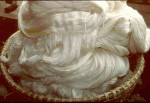 On the way back to Hanoi, we stopped at Pho Ga Noodle Soup restaurant. Pho, or noodle soup, is eaten daily by the Vietnamese, and is a favorite for breakfast. As I wrangled with my chopsticks, I watched women in conical bamboo hats called non, carrying their burdens, using only a bent wood beam slung over both shoulders (don danh) to support two enormous baskets. The women scurried toward the markets, knees bent, loaded down by fruits and vegetables. Men carrying a family of four, or perhaps a bundle of water pipes, peddled confidently by on bicycles or motorbikes.
On the way back to Hanoi, we stopped at Pho Ga Noodle Soup restaurant. Pho, or noodle soup, is eaten daily by the Vietnamese, and is a favorite for breakfast. As I wrangled with my chopsticks, I watched women in conical bamboo hats called non, carrying their burdens, using only a bent wood beam slung over both shoulders (don danh) to support two enormous baskets. The women scurried toward the markets, knees bent, loaded down by fruits and vegetables. Men carrying a family of four, or perhaps a bundle of water pipes, peddled confidently by on bicycles or motorbikes.
As we made our way back to a charming turn-of-the-century hotel, I slipped into a quiet reverie, far from the swarming traffic, dust, noise, and pollution of Hanoi. And I thought about the conversation I would have with Bob when I returned.
In 1967, Barnett’s plane was shot down 11 miles from Hanoi as he was bombing a pontoon bridge. Engine aflame, he bailed out and hid in the jungle. After three days, the North Vietnamese located him using search dogs. They blindfolded him and took him to the Hanoi Hilton, where he was tortured for days.
What’s left of the prison took me about an hour to tour. Bob Barnett was imprisoned there for 989 days during the Vietnam War-five and a half years spent alone, shackled in a small, dank, unlit cell with a cement bunk and a bucket latrine. I cried during my brief visit. Barnett did as well-but he also counted the days, memorized the names of other prisoners, and communicated with the other POWs by tapping on a shared wall using a Boy Scout alphabetical code.
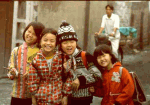 At first, Barnett was unaware of the compressed back fracture he suffered on landing, because the pain was masked by the injuries caused by tortuous beatings. His captors considered him a “criminal,” not a prisoner of war, and would not release his name for two and a half years. Anita, his wife of 15 years, knew that Bob was listed as MIA (missing in action), but not whether he was alive or dead. During those years, she lived with the hope that her husband had survived.
At first, Barnett was unaware of the compressed back fracture he suffered on landing, because the pain was masked by the injuries caused by tortuous beatings. His captors considered him a “criminal,” not a prisoner of war, and would not release his name for two and a half years. Anita, his wife of 15 years, knew that Bob was listed as MIA (missing in action), but not whether he was alive or dead. During those years, she lived with the hope that her husband had survived.
“After I was captured, they tortured me for days. They tied ropes around me until I was tight like a ball. I could barely breathe, much less give them the confession they wanted. When the beatings ended, Barnett was left to live or die. He remembers, “I stunk so bad, the Vietnamese guards wouldn’t enter the cell.” His sole job during those years of imprisonment was to place the latrine bucket outside his cell and retrieve it, empty, later in the day. And he looked forward to his release, predicting that “imaginary” day several months at a time. As the war continued he extended the date of freedom.
Eventually, life in the prison improved by infinitesimal degrees. twice a day the prisoners were fed rice and the “soup of the quarter,” a concoction of seasonal cabbage, pumpkin, or “green weeds.” They were also given a small pitcher of water each day.
Barnett was given two worn blankets, a cup, a broken stub of a toothbrush, and-occasionally-some toilet paper. Rubber tire thongs and pajamas were later provided. He was not allowed to receive mail for three years, and never saw the Red Cross representatives whom the Geneva Convention specifies must monitor the condition of prisoners of war.
When I returned from Hanoi., I asked Bob how he felt about my visiting the site of his living nightmare. Had I intruded on his memories, brought back his years of torture? He thought for a while and replied: the nightmares have waned in the 25 years since his release. However, unlike other veterans who have returned to Vietnam to satisfy their curiosity-or face down old ghosts-he has no interested in returning to the Hanoi Hilton, ever again. “I still have those pajamas in the garage, but I don’t remember where they are.”
